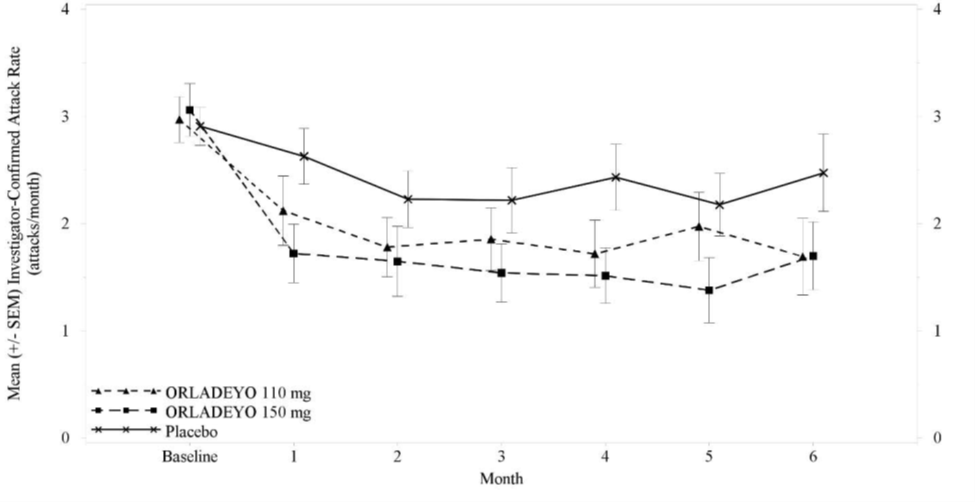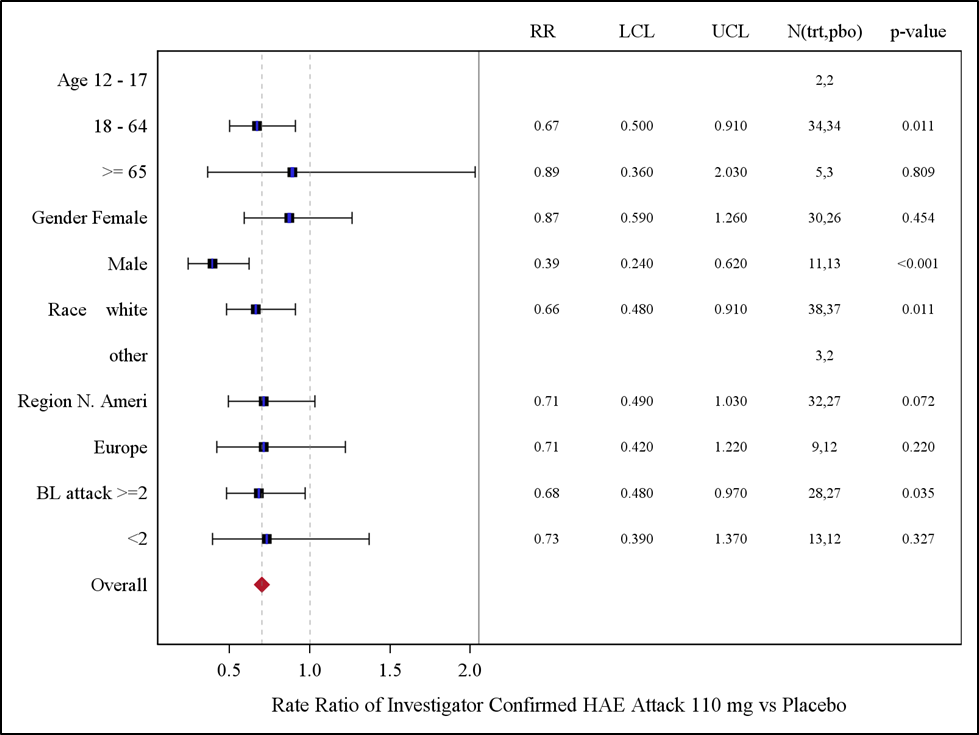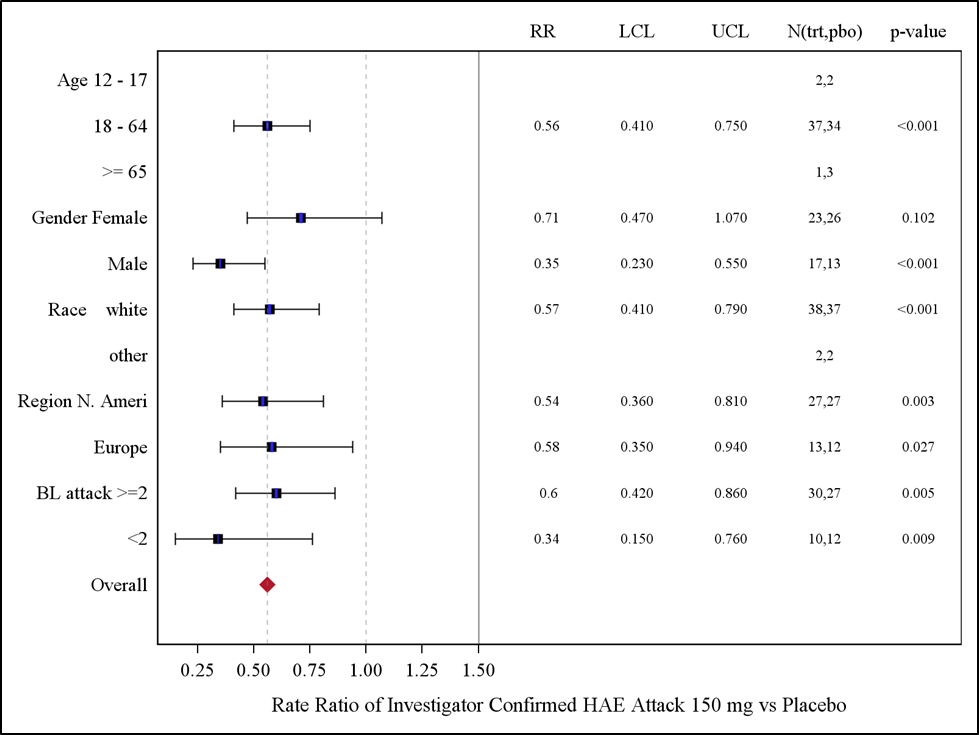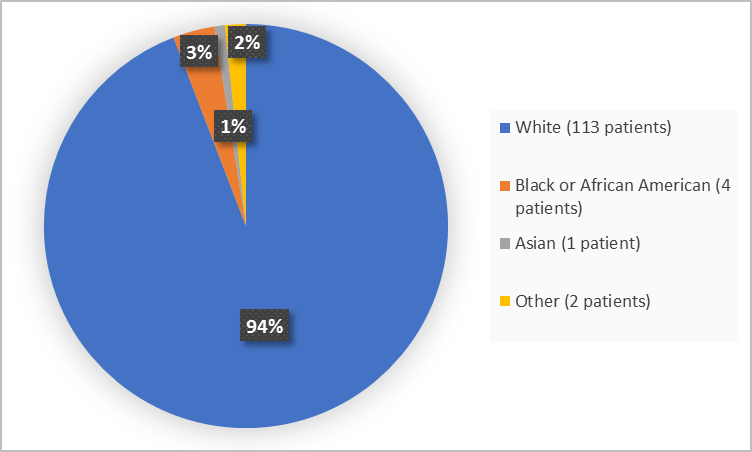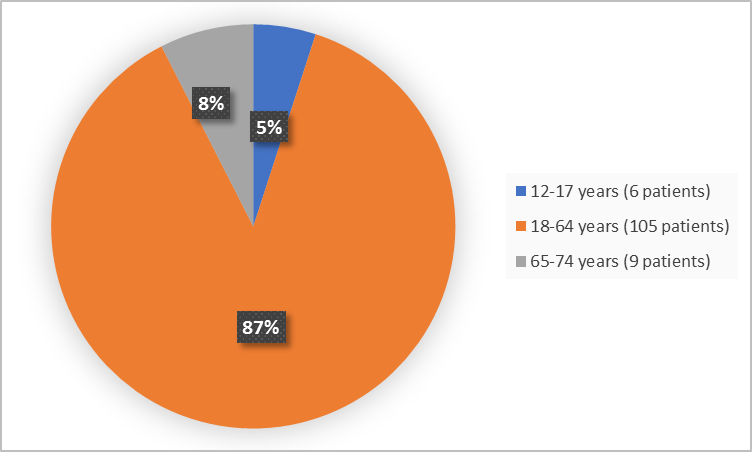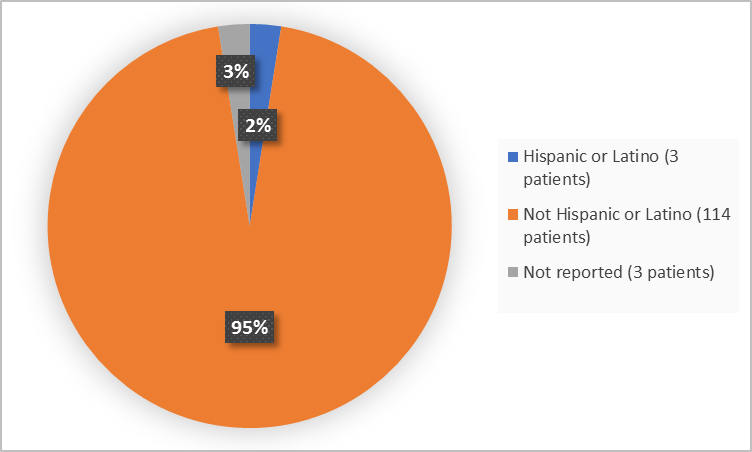Drug Trials Snapshot: Orladeyo
HOW TO USE THIS SNAPSHOT
The information provided in Snapshots highlights who participated in the clinical trials that supported the FDA approval of this drug, and whether there were differences among sex, race and age groups. The “MORE INFO” bar shows more detailed, technical content for each section. The Snapshot is intended as one tool for consumers to use when discussing the risks and benefits of the drugs.
LIMITATIONS OF THIS SNAPSHOT:
Do not rely on Snapshots to make decisions regarding medical care. Always speak to your health provider about the risks and benefits of a drug. Refer to the ORLADEYO Package Insert for complete information.
ORLADEYO (berotralstat)
(or-luh-DAY-oh)
BioCryst Pharmaceuticals, Inc.
Approval date: December 3, 2020
DRUG TRIALS SNAPSHOT SUMMARY:
What is the drug for?
ORLADEYO is a drug used to prevent attacks of hereditary angioedema (HAE) in patients 12 years and older.
Hereditary angioedema is a rare, inherited and sometimes life-threatening condition with repeat episodes (attacks) of severe swelling in various parts of the body, including stomach, limbs, face and throat.
How is this drug used?
ORLADEYO is a capsule taken by mouth, 1 time every day with food.
What are the benefits of this drug?
Patients who received ORLADEYO had fewer angioedema attacks compared to those receiving the placebo.
What are the benefits of this drug (results of trials used to assess efficacy)?
The table below summarizes efficacy results for the evaluated patients for Trial 1. The main trial endpoint was investigator-confirmed hereditary angioedema (HAE) attack rate reduction in Intend-to Treat (ITT) population relative to placebo.
Table 1. Reduction in HAE Attack Rate- Intent-to-Treat (ITT) Population (Trial 1)
|
Outcome |
ORLADEYO |
Placebo |
|
|---|---|---|---|
|
110 mg QD |
150 mg QD |
||
|
N = 41 |
N = 40 |
N = 40* |
|
|
HAE Attack rate, rate per 28 days † |
1.65 |
1.31 |
2.35 |
|
% Rate Reduction ‡ (95% CI) |
30.0% |
44.2% |
|
|
p-value |
0.024 |
<0.001 |
|
* One patient in the ITT analysis was randomized to placebo but was not treated.
† Statistical analysis based on a negative binomial regression model; number of attacks included as dependent variable, treatment included as fixed effect, baseline attack rate included as covariate, and logarithm of duration on treatment included as offset variable.
‡ Percent reduction relative to placebo.
Figure 5. Mean (+/- SEM) HAE Attack Rate/month Through 24 Weeks (Trial 1)- ITT Population
ORLADEYO Prescribing Information
Were there any differences in how well the drug worked in clinical trials among sex, race and age?
- Sex: ORLADEYO worked similarly in males and females.
- Race: The majority of patients were White. The number of patients of other races was limited; therefore, differences in response among races could not be determined.
- Age: The majority of patients were adults 18 to 64 years of age. The number of adolescents and patients 65 years and older was limited; therefore, differences in the occurrence of side effects among younger and older age groups could not be determined.
Were there any differences in how well the drug worked in clinical trials among sex, race, and age groups?
The figures below summarize efficacy results by subgroups.
Figure 6. Subgroup Analysis of the Investigator-Confirmed HAE Attack Rate Comparing the 110 mg Group vs Placebo Group
Note: Due to extremely small number of subjects in subgroups of adolescents and other race, model-based estimate of rate ratio and CIs are considered unreliable and misleading. Therefore, they are not presented in the plot.
Abbreviations: BL attack, baseline number of attacks per month ; LCL, lower confidence limit; N. Ameri, North America; pbo, placebo group; RR, rate ratio; trt, treatment group; UCL, upper confidence limit
FDA Review
Figure 7. Subgroup Analysis of the Investigator-Confirmed HAE Attack Rate Comparing the 150 mg Group vs Placebo Group
Note: Due to extremely small number of subjects in subgroups of adolescents and other race, model-based estimate of rate ratio and CIs are considered unreliable and misleading. Therefore, they are not presented in the plot.
Abbreviations: BL attack, baseline number of attacks per month ; LCL, lower confidence limit; N. Ameri, North America; pbo, placebo group; RR, rate ratio; trt, treatment group; UCL, upper confidence limit
FDA Review
What are the possible side effects?
In people who take more than one capsule a day, ORLADEYO may cause heart rhythm problem due to prolongation of heart electrical activity (QT prolongation).
The most common side effects of ORLADEYO are abdominal pain, vomiting, diarrhea, back pain, and heartburn.
What are the possible side effects (results of trials used to assess safety)?
The table below summarizes adverse reactions in patients with hereditary angioedema.
Table 2. Adverse Reactions Observed in ≥10% of Patients in any ORLADEYO Treatment Group
|
Adverse Reaction |
Placebo |
ORLADEYO |
||
|---|---|---|---|---|
|
110 mg |
150 mg |
Total |
||
|
Abdominal Pain* |
4 (10) |
4 (10) |
9 (23) |
13 (16) |
|
Vomiting |
1 (3) |
4 (10) |
6 (15) |
10 (12) |
|
Diarrhea† |
0 |
4 (10) |
6 (15) |
10 (12) |
|
Back Pain |
1 (3) |
1 (2) |
4 (10) |
5 (6) |
|
Gastroesophageal Reflux Disease |
0 |
4 (10) |
2 (5) |
6 (7) |
* includes Abdominal pain, Abdominal discomfort, Abdominal pain upper, and Abdominal tenderness
† includes Diarrhea and Frequent bowel movements
ORLADEYO Prescribing Information
Were there any differences in side effects among sex, race and age?
- Sex: The occurrence of side effects was similar in males and females.
- Race: The majority of patients were White. The number of patients of other races was limited; therefore, differences in the occurrence of side effects among races could not be determined.
- Age: The majority of patients were adults 18 to 64 years of age. The number of adolescents and patients 65 years and older was limited; therefore, differences in the occurrence of side effects among younger and older age groups could not be determined.
Were there any differences in side effects of the clinical trials among sex, race, and age groups?
The table below summarizes the occurrence of the most common adverse reactions, by subgroup. Race subgroups were not tested because of predominance of White patients. These analyses should be interpreted with caution because of limited sample sizes and relatively rare events.
Table 3. Subgroup Analysis of Adverse Reactions by Sex
|
|
Placebo (N=39) |
ORLADEYO (N=81) |
||
|---|---|---|---|---|
|
|
Male |
Female |
Male |
Female |
|
Abdominal pain, n (%) |
1 (8) |
3 (12) |
4 (14) |
9 (17) |
|
Vomiting, n (%) |
1 (8) |
0 |
5 (18) |
5 (9) |
|
Diarrhea, n (%) |
0 |
0 |
3 (11) |
7 (13) |
Table 4. Subgroup Analysis of Adverse Reactions by Age
|
|
Placebo (N=39) |
ORLADEYO (N=81) |
||||
|---|---|---|---|---|---|---|
|
|
<18 y |
18-64 y |
≥65 y |
<18 y |
18-64 y |
≥65 y |
|
Abdominal pain, n (%) |
0 |
4 (12) |
0 |
0 |
11 (15) |
2 (33) |
|
Vomiting, n (%) |
0 |
0 |
1 (33) |
0 |
9 (13) |
1 (17) |
|
Diarrhea, n (%) |
0 |
0 |
0 |
0 |
8 (11) |
2(33) |
* includes Abdominal pain, Abdominal discomfort, Abdominal pain upper, and Abdominal tenderness
† includes Diarrhea and Frequent bowel movements
Clinical Trial Data
WHO WAS IN THE CLINICAL TRIALS?
Who participated in the clinical trials?
The FDA approved ORLADEYO based on evidence from one clinical trial (Trial 1 /NCT03485911) of 120 patients with hereditary angioedema. The trial was conducted at 40 sites in the United States, European Union and Canada.
Figure 1 summarizes how many males and females were in the clinical trial.
Figure 1. Baseline Demographics by Sex
FDA Review
Figure 2 summarizes the percentage of patients by race in the clinical trial.
Figure 2. Baseline Demographics by Race
FDA Review
Figure 3 summarizes the percentage of patients by age in the clinical trial.
Figure 3. Baseline Demographics by Age
FDA Review
Figure 4 summarizes the percentage of patients by ethnicity in the clinical trial.
Figure 4. Baseline Demographics by Ethnicity
FDA Review
Who participated in the trials?
The table below summarizes demographics of patients in the clinical trial.
Table 5. Baseline Characteristics (safety population)
|
Demographic Parameter |
ORLADEYO |
ORLADEYO |
Placebo |
TOTAL |
|---|---|---|---|---|
|
Sex, n (%) |
||||
|
Female |
30 (73.2%) |
23 (57.5%) |
26 (66.7%) |
79 (65.8%) |
|
Male |
11 (26.8%) |
17 (42.5%) |
13 (33.3%) |
41 (34.2%) |
|
Race, n (%) |
||||
|
White |
38 (92.7%) |
38 (95.0%) |
37 (94.9%) |
113 (94.2%) |
|
Black or African American |
2 (4.9%) |
1 (2.5%) |
1 (2.6%) |
4 (3.3%) |
|
Other |
0 |
1 (2.5%) |
1 (2.6%) |
2 (1.7%) |
|
Asian |
1 (2.4%) |
0 |
0 |
1 (0.8%) |
|
Age (years) |
||||
|
Mean (standard deviation) |
40.4 (17.5) |
40.0 (14.0) |
44.6 (14.3) |
41.6 (15.4) |
|
Median |
39 |
39 |
44 |
40 |
|
Range |
12-74 |
12-69 |
14-72 |
12-74 |
|
Age Group, n (%) |
||||
|
12-17 years |
2 (4.9%) |
2 (5.0%) |
2 (5.1%) |
6 (5.0%) |
|
18-64 years |
34 (82.9%) |
37 (92.5%) |
34 (87.2%) |
105 (87.5%) |
|
65-74 years |
5 (12.2%) |
1 (2.5%) |
3 (7.7%) |
9 (7.5%) |
|
Ethnicity, n (%) |
||||
|
Not Hispanic or Latino |
39 (95.1%) |
38 (95.0%) |
37 (94.9%) |
114 (95.0%) |
|
Hispanic or Latino |
0 |
2 (5.0%) |
1 (2.6%) |
3 (2.5%) |
|
Not reported |
2 (4.9%) |
0 (0.0%) |
1 (2.6%) |
3 (2.5%) |
|
Country, n (%) |
||||
|
United States |
28 (68.3%) |
24 (60.0%) |
24 (61.5%) |
76 (63.3%) |
|
Canada |
4 (9.8%) |
3 (7.5%) |
3 (7.7%) |
10 (8.3%) |
|
Czech Republic |
2 (4.9%) |
3 (7.5%) |
3 (7.7%) |
8 (6.7%) |
|
Great Britain |
1 (2.4%) |
4 (10.0%) |
2 (5.1%) |
7 (5.8%) |
|
Germany |
1 (2.4%) |
2 (5.0%) |
2 (5.1%) |
5 (4.2%) |
|
Austria |
1 (2.4%) |
2 (5.0%) |
1 (2.6%) |
4 (3.3%) |
|
France |
2 (4.9%) |
0 |
1 (2.6%) |
3 (2.5%) |
|
Spain |
0 |
0 |
2 (5.1%) |
2 (1.7%) |
|
North Macedonia |
0 |
1 (2.5%) |
1 (2.6%) |
2 (1.7%) |
|
Hungary |
2 (4.9%) |
0 |
0 |
2 (1.7%) |
|
Romania |
0 |
1 (2.5%) |
0 |
1 (0.8%) |
FDA Review
How were the trials designed?
The benefit and side effects of ORLADEYO were evaluated in one clinical trial. Trial investigators evaluated patients 12 years and older with hereditary angioedema for 8 weeks to determine the number of attacks for each patient. The trial enrolled only patients who had at least 2 attacks during the 8-week period. Patients were assigned to receive one of two doses of ORLADEYO or placebo once every day for 24 weeks. Neither the patients nor the investigators knew which treatment was being given until after the trial was completed. All patients could use other medications for treatment of attacks.
Investigators recorded the number of angioedema attacks in all treated groups over the 24 weeks. The benefit of ORLADEYO was assessed by comparing the reduction rate of HAE attacks relative to placebo over a 24-weeks treatment period.
How were the trials designed?
The efficacy and safety of ORLADEYO were established in one randomized, double-blind, placebo-controlled trial. The trial evaluated ORLADEYO for the prevention of angioedema attacks in adult and adolescent patients with Type I or II hereditary angioedema who experienced at least two investigator-confirmed attacks in the 8 weeks of the run-in period. Patients were randomized into one of three parallel treatment arms (ORLADEYO 110 mg, ORLADEYO 150 mg, or placebo) and received assigned medication once daily for 24 weeks. All patients could use rescue medications for treatment of breakthrough angioedema attacks.
The primary efficacy endpoint was the reductions in the HAE attack rate relative to placebo during the 24-week treatment period.
GLOSSARY
CLINICAL TRIAL: Voluntary research studies conducted in people and designed to answer specific questions about the safety or effectiveness of drugs, vaccines, other therapies, or new ways of using existing treatments.
COMPARATOR: A previously available treatment or placebo used in clinical trials that is compared to the actual drug being tested.
EFFICACY: How well the drug achieves the desired response when it is taken as described in a controlled clinical setting, such as during a clinical trial.
PLACEBO: An inactive substance or “sugar pill” that looks the same as, and is given the same way as, an active drug or treatment being tested. The effects of the active drug or treatment are compared to the effects of the placebo.
SUBGROUP: A subset of the population studied in a clinical trial. Demographic subsets include sex, race, and age groups.
PRESCRIBING INFORMATION

